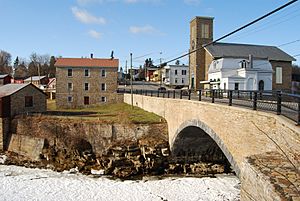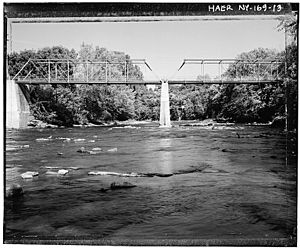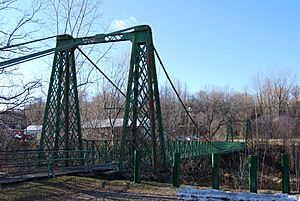Bridges of Keeseville facts for kids
The Bridges of Keeseville are three old and important bridges in Keeseville, New York. They cross the Ausable River. These bridges show how bridge building changed over time. They are so special that they were named a Historic Civil Engineering Landmark in 1987.
Contents
Discover the Keeseville Bridges
Keeseville is home to three amazing bridges. Each one was built at a different time. They show us how engineers learned to build stronger and more creative bridges. Let's explore each one!
The Stone Arch Bridge (1843)
The oldest bridge is a beautiful stone arch bridge. It was built way back in 1843. Imagine how long ago that was! This bridge is made of strong stone blocks. It uses a curved arch shape to hold up the road. This design has been used for thousands of years. It's a classic way to build a sturdy bridge.
The Iron Truss Bridge (1878)
Next, there's the iron truss bridge, built in 1878. This bridge is also called the "Upper Bridge". It's made of wrought iron, which is a type of strong metal. This bridge uses a special design called a Pratt truss. A truss is like a giant triangle framework. It helps the bridge be very strong and stable.
This bridge sits right on the border between Essex and Clinton counties. It's located just south of the main part of Keeseville. The Upper Bridge was closed in 2008. It needs some repairs to be safe again.
The Suspension Footbridge (1888)
The newest of the three is a twisted wire cable suspension footbridge. It was built in 1888. This bridge is only for people to walk across. It uses strong cables that hang between tall towers. These cables hold up the bridge deck. It's a very cool design that looks like it's floating!
Why Are These Bridges Special?
These three bridges are important because they show how bridge building changed in the 1800s. You can see the shift from old stone methods to new metal designs. They even show the start of modern suspension bridges. Because of their history and design, the American Society of Civil Engineers gave them a special award. They are a Historic Civil Engineering Landmark. This means they are very important examples of engineering.




